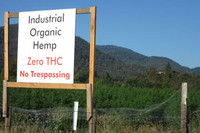This hemp clothing maker says we need a new cannabis vocabulary
Posted by Rose on 24th Sep 2019
There’s a lot of confusion about exactly what kind of plants women’s hemp clothing comes from

Back when I began making hemp women’s wear, unbelievably, hemp plants were still classified as a Schedule 1 controlled substance by the US government—right alongside heroin. And that’s just one chapter in hemp’s fraught and fascinating history in America. A history that, in the 20th century, was one rife with confusion and flawed legal policy. The Hemp Industries Association offers a brief historical background here that illustrates hemp’s up-and-down fortunes. Often vilified for its poorly understood connection with marijuana, hemp staged a heroic comeback when manila rope from the East was cut off after Pearl Harbor.
Everything changed for good though in late 2018 when Congress passed a farm bill that for the first time legalized cannabis strains containing less than .03 percent THC—the main cannabinoid responsible for marijuana’s psychoactive effects. Low-THC cannabis would now be termed industrial hemp. But using that umbrella term seems misleading to me.
Confusion still reigns about cannabis in all its forms: as a fiber, intoxicant, food oil and medicine. I think a lot of that confusion results from the lack of an agreed-upon vocabulary that differentiates all the ways in which cannabis is bred, grown, and used today. The recent visibility of products touting their hemp-derived CBD content underscores the need for further research into CBD’s potential benefits. It also calls for clearer language that distinguishes exactly what kind of cannabis is being discussed, whether from a social, legal, medical, agricultural, or commodity standpoint.
Hemp as a textile has been around for millennia. In colonial America, hemp fields were a familiar sight on farms. Used for everything from textiles, rope, oil and paper to medicinal uses, particularly during childbirth, hemp was a ubiquitous presence in early American life.
Getting back to recent history for a moment, though, hemp’s Schedule 1 designation was a holdover from Richard Nixon’s discredited War on Drugs launched in the 1970s. It reflected a failure to appreciate cannabis in all its forms and uses. The law establishing what would be deemed controlled substances made no botanical distinction among strains of cannabis grown for their THC-containing flowers (marijuana or recreational cannabis) and strains cultivated for their fiber and seed oil (now collectively called industrial hemp).
Here’s the thing: from a botanical standpoint, it’s all cannabis. Whether we’re talking about the many current strains and uses of hemp, or its more infamous botanical cousin, marijuana.
This confusion has been furthered by marijuana advocates who sometimes blur the lines between the strains and uses of cannabis. Although marijuana is consumed by many to deal with medical and psychological conditions, its recreational use has sometimes been disguised as medical use. States adopting medical marijuana programs have been inundated with young applicants whose ages run decidedly younger than typical patients. Clearly, some of those passing through clinics set up to churn out medical cannabis prescriptions were simply out to catch a legal buzz.
The blurring of cannabis strains and uses has further compounded hemp’s legitimacy problems. Even after passage of the 2018 Farm Bill, an Oregon truck driver was jailed in Idaho in January 2019 for transporting a three-ton load of hemp. Though the hemp was certified as having less than .03 percent THC content, Idaho argued the state had no means to verify this. The case has since been settled with a plea deal but confusion and resistance to hemp’s new-won legality persists.
MORE: Why Hemp Clothes Make Sense
Dig Deeper: Hemp blends for wearability
Drill down… Women's hemp clothing moves into the mainstream
How the buzz on CBD is muddying the waters
The explosion of products containing CBD includes lotions, candy, coffee, soft drinks, and even a line of activewear that has CBD sewn into the clothes, supposedly to combat inflammation and pain brought on by exercise. Walking the aisles of drug stores and supermarkets today you’ll see dozens of CBD products on their shelves. Some of these products seem to be of dubious value, and serious questions need to be raised about their purity, efficacy and the growing/extraction methods used to obtain the CBD in them.
Another confusion surrounds hemp oil made from crushed seeds versus CBD oil that comes from low-THC hemp flowers. Hemp seed oil has been used for centuries as a food—one that is rich in omega 3 fatty acids. It’s also been used in everything from paints and varnishes to animal feed. Today you’ll find hemp seed oil in all sorts of products ranging from health foods to cosmetics and body care items.
One aspect of CBD products concerns me in particular. Most of them contain CBD derived from an oil obtained by concentrating cannabis resin. If the crop has been treated with systemic pesticides and herbicides, those chemicals will be concentrated right along with the CBD.
Although the 2018 Farm Bill authorized the USDA to certify hemp crops as organic so long as they meet the standards of the agency, certified organic CBD products may be hard to find at present. A quick, non-scientific survey of my supermarket’s CBD offerings as well as an online search revealed no products actually bearing the USDA Organic seal.
Of course, the whole hemp ecosphere is brand new and in development. It will take time to implement the programs and standards necessary to ensure that hemp in all its forms is produced in environmentally sound ways. Similarly, there will be a shakeout of products that don’t meet consumer safety standards
In the meanwhile the lack of certification is worrying because our lungs have no toxicity barrier like the one in our GI tract. So if you ingest these concentrates by smoking or vaporizing non-organic CBD oils, the risk of toxicity increases. Witness the recent outbreak of vaping-related illness and deaths. Although it is yet to be determined what is causing these cases and it’s unclear to what extent CBD-containing vaporizers may be part of the problem, caution is in order.

In response to the “greenrush” surrounding CBD, new cannabis strains are being developed that are small in stature compared to traditional towering hemp varieties grown for their fiber and seed. These newer CBD-rich strains are bred to produce minimal leafy vegetation while maximizing flower and bud development—the part of the plant that contains CBD. Some of these new strains have been crossed with cannabis ruderalis, a stocky hemp subspecies from Asia and Eastern Europe that is adapted to harsh conditions and lends itself to short growing seasons. These newly minted hybrids are rapidly expanding the diversity of the hemp gene pool while making categorization more challenging than ever.
Indeed, there is still some controversy among botanists about how to classify cannabis in all its variations. The Vavilov Institute in St. Petersburg, Russia, a hub for hemp research, counts more than 400 distinct hemp varieties grown for hemp and seed. The Institute organizes these varieties based on their geographical distribution and their plant structures.
That approach to categorization may well be fine where plant agronomy is concerned. But it seems to me that in order to have useful conversations about all the potential uses of hemp, as well as cannabis generally, we need to develop a new vocabulary and naming conventions that make clear the purpose of the strain being discussed. It seems confusing to refer to all forms of hemp containing less than .03 percent THC simply as “industrial hemp.” When I think of the many therapeutic uses of CBD today, that term seems inappropriate. Clearly designating end uses and users in describing cannabis strains will help.

Where I live in Southern Oregon, hemp crops are suddenly everywhere. New hemp fields have eclipsed local acreage previously devoted to wine grapes, fruit orchards, and other traditional crops. Tourists visiting my booth at the Lithia Artisans Market in Ashland often are often curious about hemp after seeing hundreds of acres under cultivation locally.
Some of these folks mention the miles of plastic mulch used in the fields as a means of weed suppression. Some of the stuff is apparently biodegradable, but it's twice as expensive as conventional plastic mulch. The majority of the plastic used around here will end up in our landfill. Not very sustainable.
A further problem is smell. Like marijuana, most strains of hemp have a strong, skunky aroma that increases as harvest time nears. Around here, some people are complaining that the intense smell that’s evident downwind of large hemp fields aggravates their allergies and other respiratory conditions.
In trying to answer customers’ questions and clear up confusion about cannabis. I’m often struck by the lack of terminology we possess to easily differentiate among all the different strains and purposes to which hemp is put these days. Maybe that will change as CBD-infused products come under more scrutiny and we develop terms that are more meaningful to consumers interested in hemp’s therapeutic qualities. But until then, the confusion and misinformation that has surrounded this incredibly useful plant is likely to continue.
A lot of folks visiting my booth want to know if you can make clothes from all that hemp they’ve seen growing. The truth is, until we develop the infrastructure to process and weave hemp for fiber, don’t expect to see any clothes made of US-grown hemp. Specialized hemp harvesting and processing equipment will also take time to come online in the US. But hemp’s future as a fiber may actually be given a boost by the present clamor over CBD. I’m personally excited over the prospects while also cautious that the many benefits of hemp raised for fiber could be obscured in all the marketing noise over CBD. Time will tell.
Share:








